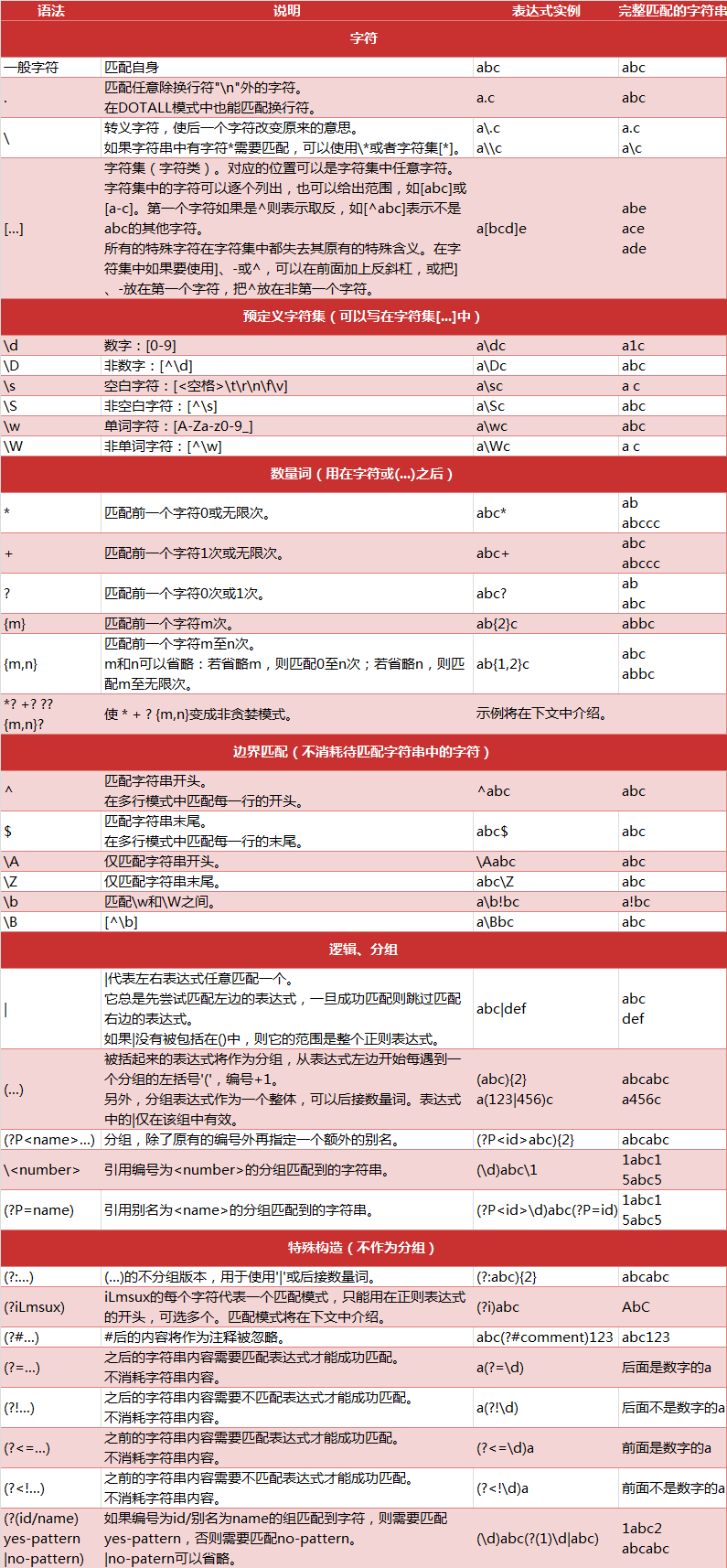什么是正则表达式
正则表达式是对字符串操作的一种逻辑公式,就是用事先定义好的一些特定字符、及这些特定字符的组合,组成一个“规则字符串”,这个“规则字符串”用来表达对字符串的一种过滤逻辑
正则表达式规则

正则表达式注意问题
数量词的贪婪模式与非贪婪模式
正则表达式通常用于在文本中查找匹配的字符串。Python里数量词默认是贪婪的,总是尝试匹配尽可能多的字符;非贪婪的则相反,总是尝试匹配尽可能少的字符。
例如:正则表达式”ab”如果用于查找”abbbc”,将找到”abbb”。
而如果使用非贪婪的数量词”ab?”,将找到”a”。
*表示匹配前一个字符0个或多个,加上?后匹配前一个字符0个或1个,使匹配规则变为非贪婪。
转义问题
由于字符串中出现特殊字符要采取转义,采用’'可以进行转义。如果字符串中出现’',需要采用’\‘才可以转义为’',
Python里的原生字符串很好地解决了这个问题,在字符串前加上r,表示原生字符串,不用考虑转义问题。
看下面的例子:
1 | import re |
使用原生字符串不用写转义的’'了。
正则表达式的应用举例
1 可以re模块中的match函数实现基本的匹配
1 | import re |
2 可以实现split切割字符串
1 | #切串 |
1 | pattern = re.compile(r'\d+') |
3 对匹配规则进行分组
1 | m = re.match(r'^(\d{3})-(\d{3,8})$','010-12345') |
4 贪婪匹配和非贪婪匹配
1 | r1 = re.match(r'^(\d+)(0*)$','102300').groups() |
5 编译生成pattern再匹配
1 | re_telephone = re.compile(r'^(\d{3})-(\d{3,8})$') |
match 的另一种写法是这样的
1 | pattern = re.compile(r'hello') |
re.compile返回值包含如下属性和函数:
属性:1.string: 匹配时使用的文本。2.re: 匹配时使用的Pattern对象。3.pos: 文本中正则表达式开始搜索的索引。值与Pattern.match()和Pattern.seach()方法的同名参数相同。4.endpos: 文本中正则表达式结束搜索的索引。值与Pattern.match()和Pattern.seach()方法的同名参数相同。5.lastindex: 最后一个被捕获的分组在文本中的索引。如果没有被捕获的分组,将为None。6.lastgroup: 最后一个被捕获的分组的别名。如果这个分组没有别名或者没有被捕获的分组,将为None。
函数:1.group([group1, …]): 获得一个或多个分组截获的字符串;指定多个参数时将以元组形式返回。group1可以使用编号也可以使用别名;编号0代表整个匹配的子串; 不填写参数时,返回group(0);没有截获字符串的组返回None;截获了多次的组返回最后一次截获的子串。2.groups([default]): 以元组形式返回全部分组截获的字符串。相当于调用group(1,2,…last)。default表示没有截获字符串的组以这个值替代,默认为None。3.groupdict([default]): 返回以有别名的组的别名为键、以该组截获的子串为值的字典,没有别名的组不包含在内。default含义同上。4.start([group]): 返回指定的组截获的子串在string中的起始索引(子串第一个字符的索引)。group默认值为0。5.end([group]): 返回指定的组截获的子串在string中的结束索引(子串最后一个字符的索引+1)。group默认值为0。6.span([group]): 返回(start(group), end(group))。7.expand(template): 将匹配到的分组代入template中然后返回。template中可以使用\id或\g、\g引用分组,但不能使用编号0。\id与\g是等价的; 但\10将被认为是第10个分组,如果你想表达\1之后是字符’0’,只能使用\g0。
下面的例子将上述属性和函数打印出来,读者可以打印看看结果
1 | #匹配:单词+空格+单词+任意字符 |
除此之外还有其他的几个函数
6 re.search(pattern, string[, flags])
search方法与match方法极其类似,区别在于match()函数只检测re是不是在string的开始位置匹配,search()会扫描整个string查找匹配
1 | import re |
7 re.findall(pattern, string[, flags])
搜索string,以列表形式返回全部能匹配的子串。
1 | pattern = re.compile(r'\d+') |
8 re.finditer(pattern, string[, flags])
搜索string,返回一个顺序访问每一个匹配结果(Match对象)的迭代器。
1 | pattern = re.compile(r'\d+') |
9 re.sub(pattern, repl, string[, count])
使用repl替换string中每一个匹配的子串后返回替换后的字符串,首先根据pattern在string中匹配,找到子串返回列表,然后根据repl规则,
替换列表中的字符串。
1 | pattern = re.compile(r'(\w+) (\w+)') |
10 re.subn(pattern, repl, string[, count])
返回 一个tuple,tuple两个元素,第一个为re.sub(pattern, repl, string[, count])的结果,第二个为匹配的子串个数。
1 | pattern = re.compile(r'(\w+) (\w+)') |
到目前为止正则表达式基本知识介绍完毕,谢谢关注我的公众号